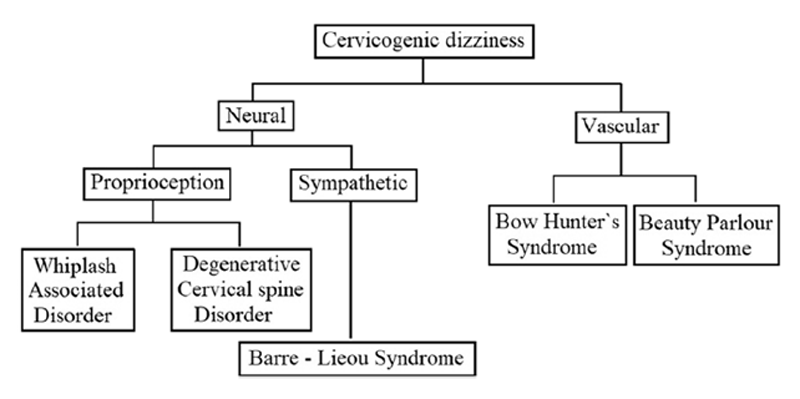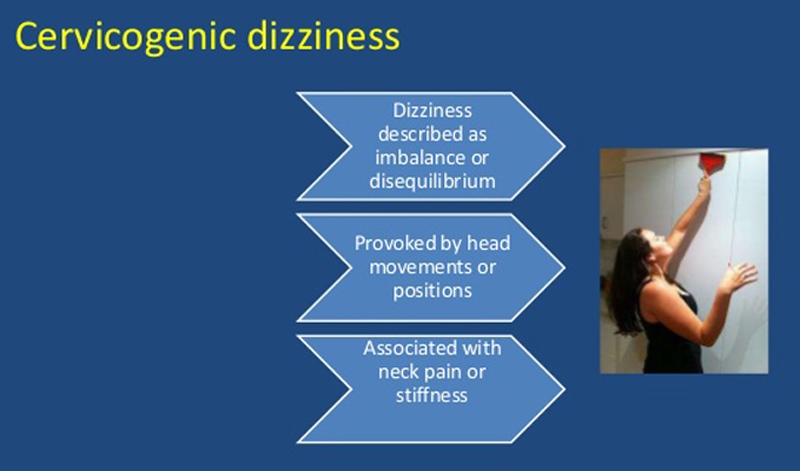Approach to Cervicogenic Dizziness: A Comprehensive Review of its Aetiopathology and Management
SOURCE: Eur Arch Otorhinolaryngol. 2018 (Oct)
K. Devaraja
Department of Otorhinolaryngology,
Kasturba Medical College,
Manipal Academy of Higher Education,
Manipal, Udupi, Karnataka, 576104, India.
PURPOSE: Though there is abundant literature on cervicogenic dizziness with at least half a dozen of review articles, the condition remains to be enigmatic for clinicians dealing with the dizzy patients. However, most of these studies have studied the cervicogenic dizziness in general without separating the constitute conditions. Since the aetiopathological mechanism of dizziness varies between these cervicogenic causes, one cannot rely on the universal conclusions of these studies unless the constitute conditions of cervicogenic dizziness are separated and contrasted against each other.
METHODS: This narrative review of recent literature revisits the pathophysiology and the management guidelines of various conditions causing the cervicogenic dizziness, with an objective to formulate a practical algorithm that could be of clinical utility.
There are more articles like this @ our:
The structured discussion on each of the causes of the cervicogenic dizziness not only enhances the readers’ understanding of the topic in depth but also enables further research by identifying the potential areas of interest and the missing links.
RESULTS: Certain peculiar features of each condition have been discussed with an emphasis on the recent experimental and clinical studies. A simple aetiopathological classification and a sensible management algorithm have been proposed by the author, to enable the identification of the most appropriate underlying cause for the cervicogenic dizziness in any given case. However, further clinical studies are required to validate this algorithm.
CONCLUSIONS: So far, no single clinical study, either epidemiological or interventional, has incorporated and isolated all the constitute conditions of cervicogenic dizziness. There is a need for such studies in the future to validate either the reliability of a clinical test or the efficacy of an intervention in cervicogenic dizziness.
KEYWORDS: Barre–Lieou syndrome; Benign paroxysmal positional vertigo; Bow hunter’s syndrome; Cervical vertigo; Cervicogenic dizziness; Whiplash-associated disorder
From the FULL TEXT Article:
Introduction
Broadly, the dizziness incorporates four descriptive symptoms: namely, ‘vertigo’, which is nothing but a false perception of movement of self or surrounding; ‘disequilibrium’ or ‘imbalance’ which is an inability to maintain balance; ‘presyncope’, a sense of losing consciousness; and ‘lightheadedness’, defined as a vague symptom of feeling disconnected from the environment. [1, 2] However, according to the Barany society’s committee for the classification of vestibular disorders, the terms ‘vertigo’ and ‘dizziness’ are non-hierarchical and reflect distinctly separate sets of symptoms. [3] They define ‘vertigo’ as the false sense of self-motion without any motion or the feeling of distorted self-motion with normal movement. Similarly, the dizziness has been defined as a sense of disturbed or impaired spatial orientation without a false or distorted sense of motion. They have further sub-classified vertigo into internal and external, for separating the vestibular sense of false motion from the visual sense of false motion, respectively. [3] Nevertheless, the patients with cervicogenic balance disorder rarely experience true vertigo; instead, they often complain of lightheadedness and disequilibrium which are included under dizziness. [4–7]
Dizziness is said to be cervicogenic when it is closely associated with the neck pain, the neck injury, or the neck pathology, after excluding the other causes of dizziness. [4] Though neurologists, neuro-otologists, physicians, and orthopedicians commonly come across patients with presumptive cervicogenic dizziness in clinics, not many would stake the claim. The dearth in the awareness about the constitute conditions contributes at least partly to this. In addition, most of the existing literature discusses the cervicogenic dizziness, in general, and provides guidelines accordingly. However, cervicogenic dizziness can be caused by many conditions of separate pathophysiological backgrounds. Failure to separate these conditions in clinical practice as well as in research studies may have a negative impact and hamper the further understanding of the disease. Apart from discussing the peculiar features of each condition responsible for the cervicogenic dizziness, this narrative review proposes a simple aetiopathological classification and a sensible management algorithm, to enable the appropriate diagnosis and management in any suspected case of cervicogenic dizziness.
Read the rest of this Full Text article now!



Leave A Comment